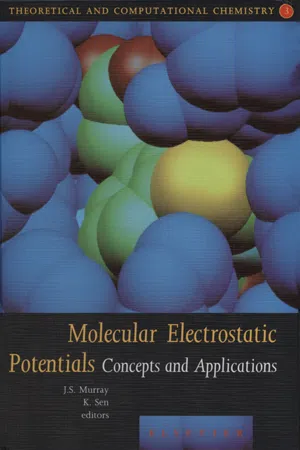
- 664 pages
- English
- ePUB (mobile friendly)
- Available on iOS & Android
About This Book
Over the past 25 years, the molecular electrostatic potential has become firmly established as an effective guide to molecular interactions. With the recent advances in computational technology, it is currently being applied to a variety of important chemical and biological systems. Its range of applicability has expanded from primarily a focus on sites for electrophilic and nucleophilic attack to now include solvent effects, studies of zeolite, molecular cluster and crystal behavior, and the correlation and prediction of a wide range of macroscopic properties. Moreover, the increasing prominence of density functional theory has raised the molecular electrostatic potential to a new stature on a more fundamental conceptual level. It is rigorously defined in terms of the electron density, and has very interesting topological characteristics since it explicitly reflects opposing contributions from the nuclei and the electrons.
This volume opens with a survey chapter by one of the original pioneers of the use of the electrostatic potential in studies of chemical reactivity, Jacopo Tomasi. Though the flow of the succeeding chapters is not stringently defined, the overall trend is that the emphasis changes gradually from methodology to applications. Chapters discussing more theoretical topics are placed near the end. Readers will find the wide variety of topics provided by an international group of authors both convincing and useful.
Frequently asked questions
Information
MEP: a tool for interpretation and prediction. From molecular structure to solvation effects
1 Introduction
2 Thirty Years Ago: The Evolution of Chemical Quantum Theory
Table of contents
- Cover image
- Title page
- Table of Contents
- Theoretical and Computational Chemistry
- Front Matter
- Copyright page
- Foreword
- Acknowledgments
- MEP: a tool for interpretation and prediction. From molecular structure to solvation effects
- Molecular Electrostatic Potentials from Density Functional Theory
- The Use of Electrostatic Potential Fields in QSAR and QSPR
- Generalization of the Molecular Electrostatic Potential for the Study of Noncovalent interactions
- Molecular Recognition via Electrostatic Potential Topography
- Molecular electrostatic potentials and fields: hydrogen bonding, recognition, reactivity and modelling
- Molecular electrostatic potentials for large systems
- Protein electrostatics
- The Lorentz-Debye-Sack theory and dielectric screening of electrostatic effects in proteins and nucleic acids
- Modelling Intrinsic Basicities: The Use of the Electrostatic Potentials and the Atoms-in-Molecules Theory
- Computed electrostatic potentials in molecules, clusters, solids and biosystems containing transition metals
- Studies on the molecular electrostatic potential inside the microporous material and its relevance to their catalytic activity
- X-ray diffraction and the potential distribution in crystals
- Molecular Electrostatic Potentials vs. DFT descriptors of reactivity
- Electrostatic Potential, Bond Density and Bond Order in Molecules and Clusters
- Relationships of Electrostatic Potentials to Intrinsic Molecular Properties
- Index